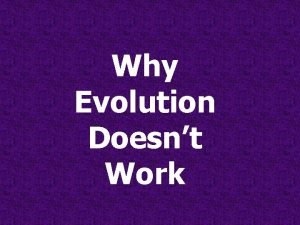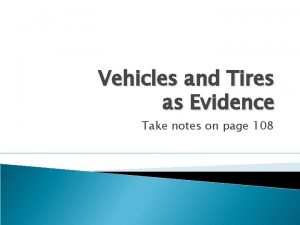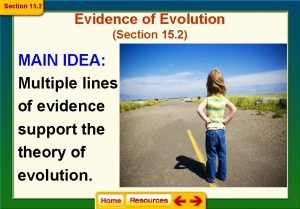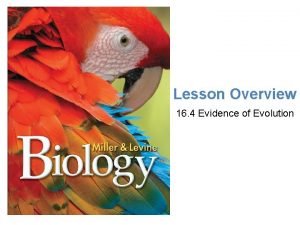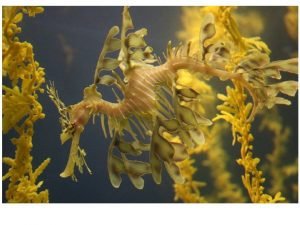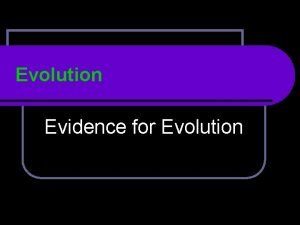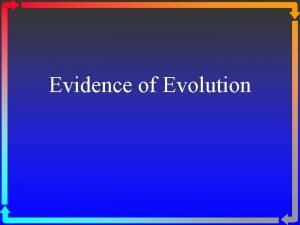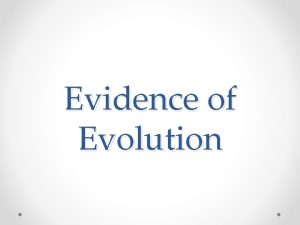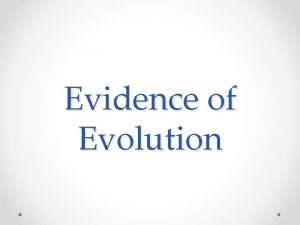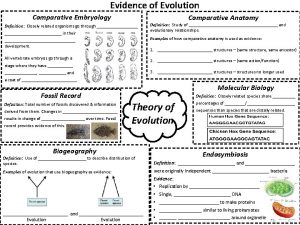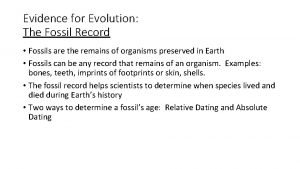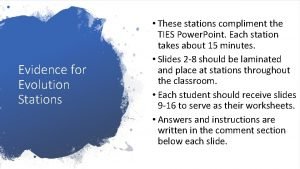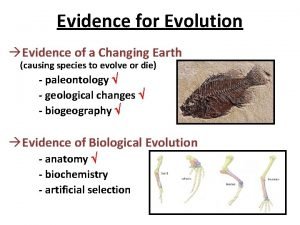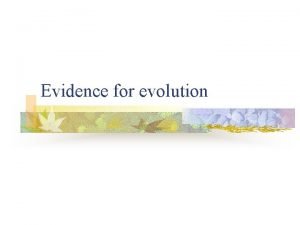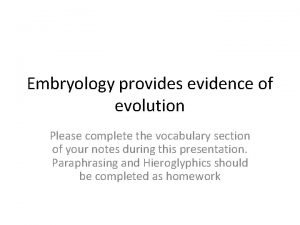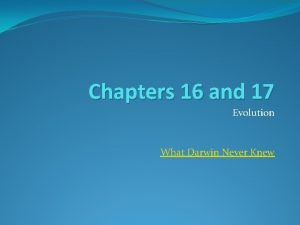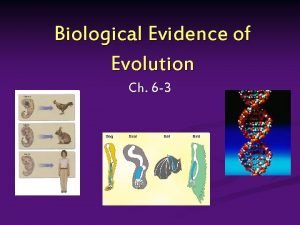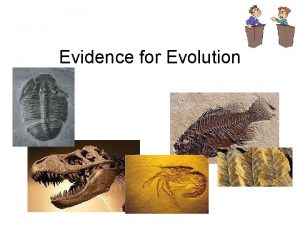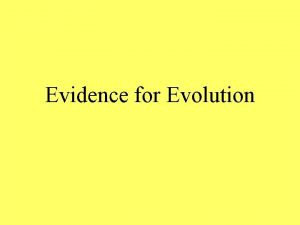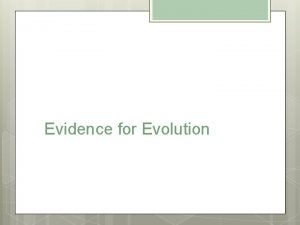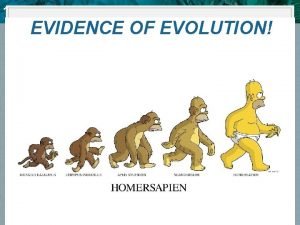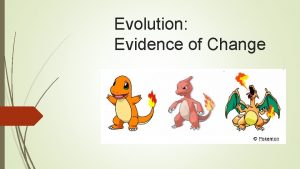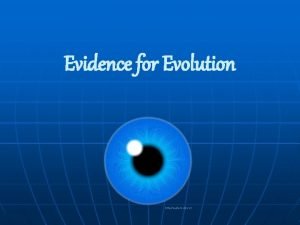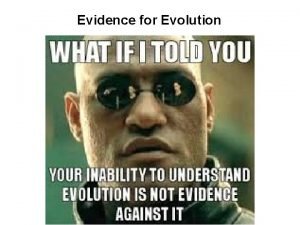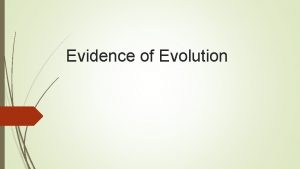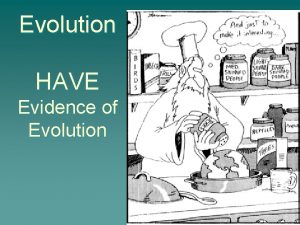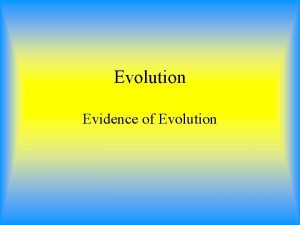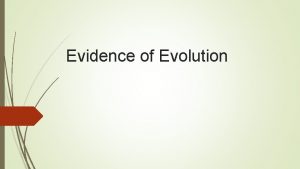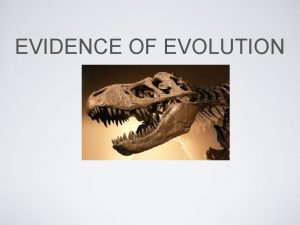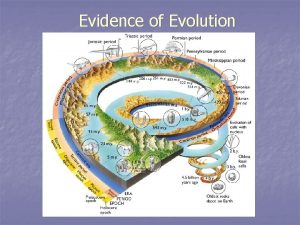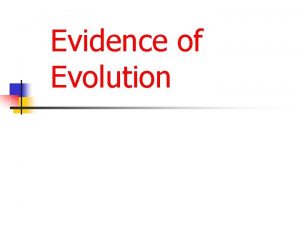Evolution EVIDENCE FOR THEORY Evidence for Evolution 1

















- Slides: 17

Evolution EVIDENCE FOR THEORY

Evidence for Evolution � 1) Developmental Biology � Embryology ( study of embryo’s) After fertilization in the first few stages of development all embryo’s look the same Confirms COMMON ANCESTOR � DNA –code of life Matching code in different organisms means they have a COMMON ANCESTOR

Evidence Continued � 2) Comparative Anatomy – (Evolutionary Biology) � Looking at different organisms physical structures (bones) we find the SAME BONES IN THE SAME PLACE--not the same function!

Homologous and Vestigial �Homologous Structures- Physical structures that are similar between different organisms. � Provides evidence for evolution because it shows that different organisms share the shame physical trait (same bones in the arm). The seemingly unrelated organisms must share a common ancestor. �Vestigial Structures- Physical structures that an organism has but doesn’t need. � Provides evidence for evolution because it shows that an ancestor of that organism had used the structure but through evolution the current organism has no use for it.

Evidence Continued � 3) Anthropology � We can compare early hominid fossils to modern humans to find similarities. We fill in the gaps of our species history � Find COMMON ANCESTORY

Evidence continued � 4) Paleontology – Fossils and Strata � Simplest organisms in the oldest rock � Complex organisms in younger rocks � Shows change over time!! � Helps identify COMMON ANCESTOR

Evolution By Natural Selection �Natural Selection is the mechanism by which evolution happens �Takes a LONG time �~ 1000 generations �Time between generations depends on the organisms reproductive rate 1 Human generation = 20 years 1 Bacteria generation = 20 Min.

Catalyst �Using the words mutation, variation and adaptation. Explain how that chameleon from yesterday developed the ability to change color

Evolution by Natural Selection Cont… �Evolution is created by changes within the DNA of an organism resulting in a NEW SPECIES �Mutation� Bad Death, lose the game of evolution � Good Aid in survival, get passed along to offspring �Variation- populations of the same species w/differences � Some organisms have the beneficial mutation some don’t �Adaptation– a beneficial trait or characteristic present in an organisms DNA that aids in survival

Adaptations come about by… � Avoidance of Predation – Need adaptations to avoid predators (camouflage, running fast, spikes, etc) � Need for Food—Need adaptations that allow you to eat (Sharp teeth, claws, etc…) � Need for a Mate– Adaptations that make you more appealing to potential mates (colors in birds, Sound in insects) � Competition in all of these areas acts as a strong pressure forcing along the process of natural selection.

Competition for Resources �Wild populations are relatively stable in size because they are limited by the availability of resources. � Remember your lab…. � What happened if there were to many predators in a given hunting area? � What happened to the prey population if there weren't enough predators? � What resources would have stopped the prey population from growing out of control? �Competition for resources insures that only those that CAN survive get to reproduce. �Only organisms with the most beneficial traits will survive. Others get eaten or die off.

Competition Video �http: //www. youtube. com/watch? v=LU 8 DDYz 68 k. M �Questions: Who was competing for resources? Who won? Why would the lions risk their lives to catch the water buffalo? What are some of the adaptations that the water buffalo have that makes them better able to survive?

Adaptations develop out of these selective pressures �Predators and prey develop camouflage � both get faster

Competition for a mate

Limits on Population Size If a population size gets too big they will exhaust their food resources and the population will decrease (die from hunger) If the population grows to large it also leaves them prone to the spread of disease. The bigger the population the faster illness spreads.

Evolution by Artificial Selection �Humans select for the desired traits and characteristics of a species

Exit ticket: (turned in on ¼ sheet of paper) �With your group: � Discuss how the different varieties of cabbage have developed �Using the words, adaptation, trait, evolution and artificial selection describe how broccoli evolved from the wild mustard plant.
 Evidence of evolution
Evidence of evolution Evidence for evolution doodle notes
Evidence for evolution doodle notes Section 15-2 evidence of evolution answer key
Section 15-2 evidence of evolution answer key Embryology evidence
Embryology evidence Convergent evolution definition
Convergent evolution definition Embryology evidence
Embryology evidence What are the 4 types of evidence for evolution
What are the 4 types of evidence for evolution What are the four main lines of evidence for evolution?
What are the four main lines of evidence for evolution? What are the four types of evidence for evolution
What are the four types of evidence for evolution Anatomy and embryology evidence of evolution
Anatomy and embryology evidence of evolution How amber is formed
How amber is formed Evidence of evolution stations
Evidence of evolution stations Biochemical evidence examples
Biochemical evidence examples Embryology evidence of evolution
Embryology evidence of evolution Evidence for evolution
Evidence for evolution Charles darwin
Charles darwin Biological evidence of evolution
Biological evidence of evolution Evidence of evolution
Evidence of evolution
